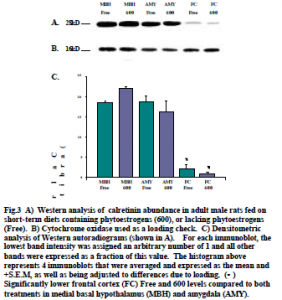Melanie A. Watson and Dr. Edwin D. Lephart, Zoology
Cyclooxygenase, a bifunctional enzyme, converts arachadonic acid to prostaglandins that are important for maintaining critical physiological functions such as nervous system regulation, pain response, and specifically inflammation of tissues. The enzyme exists in two isoforms: COX-1 is constitutionally produced, playing important maintenance roles throughout the body. COX-2 is constitutionally produced in the brain, but is inducible and thus, highly regulated (2). Non-specific inhibition of COX reduces inflammation, but increases gastrointestinal ulcers due to a failure of mucus production by COX-1. Specific COX-2 inhibition controls the inflammatory response, but is not ulcergenic (1,3). At this time the effect of COX-2 regulation on the CNS is unknown.
Estrogens are critical compounds in the body involved in the inflammatory response, pain regulation, age-related, as well as hormone controlled diseases in the brain and throughout the body. Phytoestrogens, non-steroidal, estrogen-like substances found in many plants, have potential protective effects in hormone-dependent cancers (breast and prostate), cardiovascular disease, and osteoporosis. These mimics they have the ability to bind to estrogen receptors agonistically or antagonistically (4). Continual inflammation of tissue can increase the possibility of cancer onset. Due to the similarity of roles played by estrogens and COX-2 in inflammation control, evidence suggests that they are connected in a regulatory relationship.
Calcium binding proteins serve a potentially important role in both the development and function of the CNS. Their primary action is to buffer intracellular calcium levels, thus functioning as a neuroprotective mechanism against pre-mature apoptosis. Previous data reported by our laboratory supports potential regulation of calcium binding proteins, specifically calbindin (CALB) and calretinin (CALRET), two prevalent calcium binding proteins in neurons, by estrogens. Due to the importance of these proteins in the CNS and their regulatory relationship to estrogens, the effect of phytoestrogens remains to be determined.
Sprague-Dawley (50 day-old) male rats were obtained from Charles River Lab. (Wilmington, MA, USA) and were housed in a controlled environment. The animals were given free access to water and a phytoestrogen-rich or phytoestrogen-free diet. At 70 days of age, the rats were randomly assigned to two treatment groups: 1) Phytoestrogen sterol-free diet (referred to hereafter as the Free diet, obtained from Ziegler Bros., Gardner, PA, USA) or, 2) the Phytoestrogen-containing diet (referred to hereafter as the 600 diet). After a short-term exposure on the diets, at approximately 105 days of age, the male rats were sacrificed and brain tissue samples were collected from three sites: medial basal hypothalamus (MBH), amygdala (AMY), and frontal cortex (FC). Protein abundance was determined by Western blot analysis. The immunoreactive bands were quantified by measuring optical density. The data were then tested by analysis of variance and compared against each other by pairwise comparison (via Tukey’s analysis) to determine significant differences between treatment groups (“=p<0.05). The animals and methods of this study were approved by the IACUC (Institute of Animal Care and Use Committee) at Brigham Young University.
Following statistical analysis of the data, the following results were obtained. COX-2 abundance was significantly increased in the frontal cortex compared the AMY and MBH that were approximately equal (see Fig.1). There was no notable difference between treatments for any of the brain sites. Calbindin and calretinin levels were dramatically decreased in the FC compared to MBH and AMY that were approximately equal. Again, there were no differences between treatments (see Fig.2 and 3, respectively).
Based on the results of this study short-term exposure of dietary phytoestrogens, these estrogen mimics have no effect on the levels of calretinin, calbindin, and COX-2. However, this study helped to better understand the distribution of these molecules within the brain, especially COX- 2, for which little is known in the CNS. Currently under study is the effect of long-term phytoestrogen exposure on protein abundance as well as RNA expression, of calbindin, calretinin, and COX-2.


